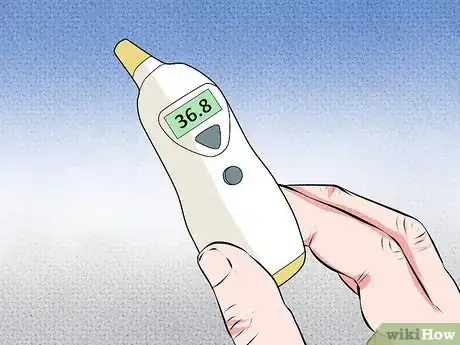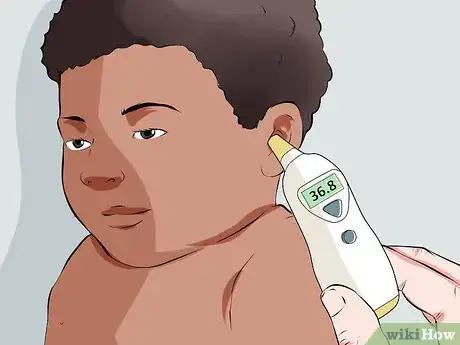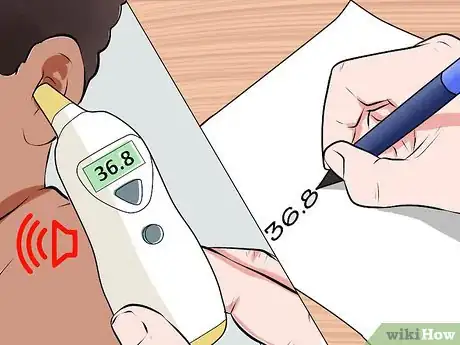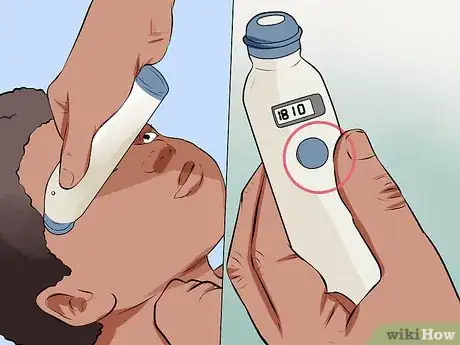This article was co-authored by Laura Marusinec, MD and by wikiHow staff writer, Jessica Gibson. Dr. Marusinec is a board certified Pediatrician at the Children's Hospital of Wisconsin, where she is on the Clinical Practice Council. She received her M.D. from the Medical College of Wisconsin School of Medicine in 1995 and completed her residency at the Medical College of Wisconsin in Pediatrics in 1998. She is a member of the American Medical Writers Association and the Society for Pediatric Urgent Care.
This article has been viewed 18,361 times.
It can be frightening to have a baby that feels feverish. A fever is the body's way of telling you that something is going on. When your baby has a fever, it could be a sign of an impending illness, such as the flu, a reaction to a vaccine, or it could be related to a current infection. There are many thermometers and ways of taking your baby's temperature. Consider your baby's age and find the best method for you and your child. Record the temperature so you can inform your baby's doctor about any concerns you have.
Steps
Taking an Armpit (Axillary) Temperature
-
1Get a digital thermometer. To take your baby's temperature by placing a thermometer in the armpit, you'll need a simple digital thermometer. You can find digital thermometers at you local pharmacy or grocery store. While this is one of the easiest ways to take your baby's temperature, it's also not as accurate as the other methods.[1]
- You shouldn't use take your baby's temperature from the baby's armpit if the baby is under three months. This is because an accurate reading is important for newborns.
-
2Place the thermometer in the armpit. Take off your baby's shirt or onesie. Turn on the digital thermometer and put it under an armpit so that it comes into contact with the skin. If your baby has been bundled up or has just taken a warm bath, wait about 15 minutes before taking the baby's temperature since these things can cause inaccurate readings.[2]
- Read the instruction manual that came with your thermometer so you know proper placement and sounds that the thermometer will make when it takes a temperature.
-
3Keep the thermometer in place. The baby's armpit should be dry so the thermometer stays in place easily. Fold your baby's arm so the elbow is against the chest. This will help keep the thermometer in place.[3]
- You may want to distract your baby while you keep the thermometer in place. Read your baby a story, put on a show, or distract the baby with a toy.
-
4Wait for the temperature and record the reading. Although digital thermometers are easy to use to take a temperature, they take longer to work. You'll need to keep your child still for a minute or two while the thermometer works. Wait until you hear beeps or a signal that the temperature is ready. Write down the temperature.[4] [5]
- Read your instruction manual to see if the thermometer will record and store the temperature so you can refer back to it later.
Taking an Ear (Tympanic) Temperature
-
1Get a tympanic (ear) thermometer. A digital tympanic thermometer measures the infrared heat waves from your baby's eardrum. These thermometers have a narrowed tip that is inserted into the outer ear canal. Many come with protective plastic coverings that you can discard after each reading.[6]
- Tympanic thermometers are best for babies over six months old. The ear canals of babies younger than six months are too small to get accurate readings.
-
2Turn on the thermometer and insert the tip. The thermometer should be on when you insert the tip and direct it toward the baby's opposite eye. If your baby is over one year old, you should also pull the baby's earlobe slightly outward before you insert the thermometer. This will straighten the ear canal for an accurate reading.[7] [8]
- Many tympanic thermometers will make a sound or alert you if the thermometer isn't inserted correctly or if it can't take an accurate reading. Be sure to read your owner's manual.
-
3Wait for the beep and record the temperature. Depending on your thermometer, you may need to wait a few seconds before pressing a button to record the temperature. Your digital thermometer may work without you needing to press anything. Either way, the thermometer will probably beep when a temperature is taken. Remove the thermometer and record the temperature.[9] [10]
- If your baby has been outside on a chilly day, wait 15 minutes before checking the temperature. Don't worry if your baby has tubes in its ears or earwax since these shouldn't affect the temperature reading.
- Note also that the temperature may not be accurate if your baby has an ear infection on the side you take it.
Taking a Rectal Temperature
-
1Get a thermometer. To take a rectal temperature, you'll need a multi-use digital thermometer or a rectal thermometer. The thermometer should have a flexible tip with a wide handle so you can easily insert it just a little into the baby's rectum. If you use a multi-use digital thermometer, designate it just for use in taking rectal temperatures. Get another digital thermometer if you plan on taking oral or axillary temperatures.[11]
- Taking your baby's temperature rectally is one of the most accurate ways to check temperature, especially in babies from newborn age to three years old.
-
2Clean and lubricate the thermometer. Dip a cotton swab in rubbing alcohol and rub it over the tip of the digital thermometer. You could also wash the tip in soap and water if you don't have rubbing alcohol. Rinse the soap away with cool water. Rub a little bit of petroleum jelly or lubricant on the end of the thermometer.[12]
- Avoid rinsing the thermometer with hot water since this could cause inaccurate temperature readings.
-
3Position your baby. Lay your baby belly down across your lap or on a table. Keep your baby still by putting the palm of your hand against the baby's lower back near the bottom.[13]
- If your baby squirms too much, try keeping your baby face up. Bend your baby's legs towards the chest so the bottom is exposed.
-
4Insert the thermometer and take the temperature. Use your free hand to gently insert the thermometer into your baby's rectum. You should only insert it 1/2 inch to an inch (1.3 to 2.5 cm). Hold the thermometer in place while cupping your baby's bottom. Leave the thermometer in place until you hear a beep, signaling that the temperature was recorded. Remove the thermometer and write down the temperature.[14]
- If you insert the thermometer more than an inch, you risk damaging your baby's rectum.[15]
Taking a Forehead Temperature
-
1Get a thermometer. You'll need a temporal artery (forehead) thermometer. These are usually digital and work by recording the temperature of infrared heat waves from the temporal artery in the baby's forehead. This type of thermometer can be expensive, but it's easy to use.[16]
- Temporal artery (forehead) thermometers work reliably in babies of all ages and are likely more accurate than axillary (armpit) thermometers in babies under three months old. (A rectal temperature is still recommended for babies under 3 months old.)
-
2Put the thermometer sensor on the forehead. The temporal artery thermometer will have a circular tip that looks like a flattened knob. Place this sensor head on the center of your baby's forehead.[17]
- Make sure you're using a digital thermometer designed for temporal artery readings. These are not the same as forehead strips, which should not be used because they're too inaccurate.
-
3Swipe the sensor across the forehead. Press down the thermometer's "on" or "start" button while you slowly move the thermometer's sensor across your baby's forehead. Keep holding down the button until you reach the top of the baby's ear.[18]
- Keep the sensor against your baby's skin the entire time you sweep it across the forehead.
- Or, follow the manufacturer's directions on the package, especially while you are learning how to use the thermometer.
-
4Stop and release the button. You can stop holding down the button when you get to your baby's hairline. By this point, the thermometer should display your baby's temperature on the digital screen. Record the temperature.[19]
- The reading should only take a couple of seconds, making this the fastest and one of the most accurate way to take your baby's temperature.
Warnings
- Avoid using glass mercury thermometers. Mercury is a toxin and pediatricians now recommend that families remove all mercury sources from their home.⧼thumbs_response⧽
- Pacifier thermometers are another type, but oral temperatures aren't considered as accurate until a child is over three years old. You should wait till your child is four or five before using a digital thermometer to take an oral temperature.⧼thumbs_response⧽
- Avoid using strip thermometers that are placed over the baby's forehead. These are inaccurate.⧼thumbs_response⧽
Things You'll Need
- Digital baby thermometer of your choice
- Alcohol
- Soap and water
- Lubricant or petroleum jelly
- Thermometer tip coverings
References
- ↑ http://www.babycenter.com/0_how-to-take-your-babys-temperature_11508.bc
- ↑ http://m.kidshealth.org/en/parents/fever.html
- ↑ http://m.kidshealth.org/en/parents/fever.html
- ↑ http://m.kidshealth.org/en/parents/fever.html
- ↑ http://www.stlouischildrens.org/articles/kidcare/fever-how-take-the-temperature
- ↑ https://www.healthychildren.org/English/health-issues/conditions/fever/Pages/How-to-Take-a-Childs-Temperature.aspx
- ↑ http://www.summitmedicalgroup.com/library/pediatric_health/hhg_how_to_measure_temperature/
- ↑ http://www.stlouischildrens.org/articles/kidcare/fever-how-take-the-temperature
- ↑ http://www.summitmedicalgroup.com/library/pediatric_health/hhg_how_to_measure_temperature/
- ↑ http://www.stlouischildrens.org/articles/kidcare/fever-how-take-the-temperature
- ↑ https://www.healthychildren.org/English/health-issues/conditions/fever/Pages/How-to-Take-a-Childs-Temperature.aspx
- ↑ https://www.healthychildren.org/English/health-issues/conditions/fever/Pages/How-to-Take-a-Childs-Temperature.aspx
- ↑ https://www.healthychildren.org/English/health-issues/conditions/fever/Pages/How-to-Take-a-Childs-Temperature.aspx
- ↑ https://www.healthychildren.org/English/health-issues/conditions/fever/Pages/How-to-Take-a-Childs-Temperature.aspx
- ↑ http://www.babycenter.com/0_how-to-take-your-babys-temperature_11508.bc
- ↑ https://www.healthychildren.org/English/health-issues/conditions/fever/Pages/How-to-Take-a-Childs-Temperature.aspx
- ↑ http://www.stlouischildrens.org/articles/kidcare/fever-how-take-the-temperature
- ↑ http://www.stlouischildrens.org/articles/kidcare/fever-how-take-the-temperature
- ↑ http://www.summitmedicalgroup.com/library/pediatric_health/hhg_how_to_measure_temperature/
About this article
To use a baby thermometer, place a digital thermometer under their arm if your baby is more than 3 months old. Once it’s in place, put your baby’s arm across their chest to prevent the thermometer from falling out, and wait until it beeps, which means the temperature is ready. If your baby is younger than 3 months or you want a more accurate reading, clean the tip of the thermometer with alcohol solution and apply petroleum jelly. Then, lay your baby face down across your lap, and gently insert the thermometer 1/2 inch into their rectum. Make sure to be careful when doing this, since inserting it more than 1 inch can injure your baby. For tips from our Medical co-author, including how to use a tympanic ear thermometer, keep reading!

































